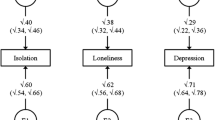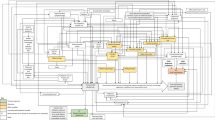Abstract
This article describes the computation and relative merits of likelihood-based confidence intervals, compared to other measures of error in parameter estimates. Likelihood-based confidence intervals have the advantage of being asymmetric, which is often the case with structural equation models for genetically informative studies. We show how the package Mx provides confidence intervals for parameters and functions of parameters in the context of a simple additive genetic, common, and specific environment threshold model for binary data. Previously published contingency tables for major depression in adult female twins are used for illustration. The support for the model shows a marked skew as the additive genetic parameter is systematically varied from zero to one. The impact of allowing different prevalence rates in MZ vs. DZ twins is explored by fitting a model with separate threshold parameters and comparing the confidence intervals. Despite the improvement in fit of the different prevalences model, the confidence intervals on all parameters broaden, owing to their covariance.
Similar content being viewed by others
REFERENCES
Arbuckle, J. (1994). AMOS 3.51 Documentation Package. Smallwaters Inc., Chicago.
Agresti, A. (1990). Categorical Data Analysis, Wiley, New York.
Bentler, P. M. (1989). EQS: Structural Equations Program Manual, BMDP Statistical Software, Los Angeles.
Bollen, K. A. (1989). Structural Equations with Latent Variables, John Wiley, New York.
Cohen, J. (1994). The earth is round. (P <.05) Am. Psychol. 49:997–1003.
Dolan, C. V., and Molenaar, P. C. M. (1991). A comparison of four methods of calculating standard errors of maximum likelihood estimates in the analysis of covariance structure. Br. J. Math. Stat. Psychol. 44:359–368.
Edwards, A. W. F. (1972). Likelihood, Cambridge, London.
Falconer, D. (1965). The inheritance of liability to certain diseases, estimated from the incidence among relatives. Ann. Hum. Genet. 29:51–76.
Fisher, R. A. (1922). On the mathematical foundations of theoretical statistics. Phil. Trans. Roy. Soc. London Ser. A 222:309–368.
Gill, P. E., Murray, W., and Wright, M. H. (1991). Numerical Linear Algebra and Optimization, Vol. 1, Addison-Wesley, New York.
Hopper, J. L., and Culross, P. R. (1983). Covariation between family members as a function of cohabitation history. Behav. Genet. 13:459–471.
Jöreskog, K. G., and Sörbom, D. (1989). LISREL 7: A Guide to the Program and Applications, 2nd ed., SPSS, Inc., Chicago.
Kendler, K. S., Neale, M. C., Kessler, R. C., Heath, A. C., and Eaves, L. J. (1992). A population based twin study of major depression in women: Varying definitions of illness. Arch. Gen. Psychiatry 49:257–266.
Kendler, K. S., Neale, M. C., Kessler, R. C., Heath, A. C., and Eaves, L. J. (1993). A test of the equal-environment assumption in twin studies of psychiatric illness. Behav. Genet. 23:21–27.
Meeker, W. Q., and Escobar, L. A. (1995). Teaching about approximate confidence regions based on maximum likelihood estimation. Am. Stat. 49(1):48–53.
Neale, M. C. (1995). Mx: Statistical Modeling, 3rd ed., Box 980126 MCV, Richmond VA 23298.
Neale, M. C., and Cardon, L. R. (1992). Methodology for Genetic Studies of Twins and Families, Kluwer Academic, Dordrecht.
Neale, M. C., Heath, A. C., Hewitt, J. K., Eaves, L. J., and Fulker, D. W. (1989). Fitting genetic models with LISREL: Hypothesis testing. Behav. Genet. 19:37–69.
Popper, K. R. (1961). The Logic of Scientific Discovery, Science Editions (translation: original work published 1934).
Rowe, D. C. (1994). The Limits of Family Influence: Genes, Experience, and Behavior, Guilford Press, New York.
SAS (1988). SAS/STAT User's Guide: Release 6.03, SAS Institute, Inc., Cary, NC.
Savitz, D. A. (1993). Is statistical significance testing useful in interpreting data? Reprod Toxicol. 7:95–100.
Silvey, S. D. (1975). Statistical Inference, Chapman and Hall, London.
Venzon, D. J., and Moolgavkar, S. H. (1988). A method for computing profile-likelihood-based confidence intervals. ApplStat, 3.
Author information
Authors and Affiliations
Rights and permissions
About this article
Cite this article
Neale, M.C., Miller, M.B. The Use of Likelihood-Based Confidence Intervals in Genetic Models. Behav Genet 27, 113–120 (1997). https://doi.org/10.1023/A:1025681223921
Issue Date:
DOI: https://doi.org/10.1023/A:1025681223921




